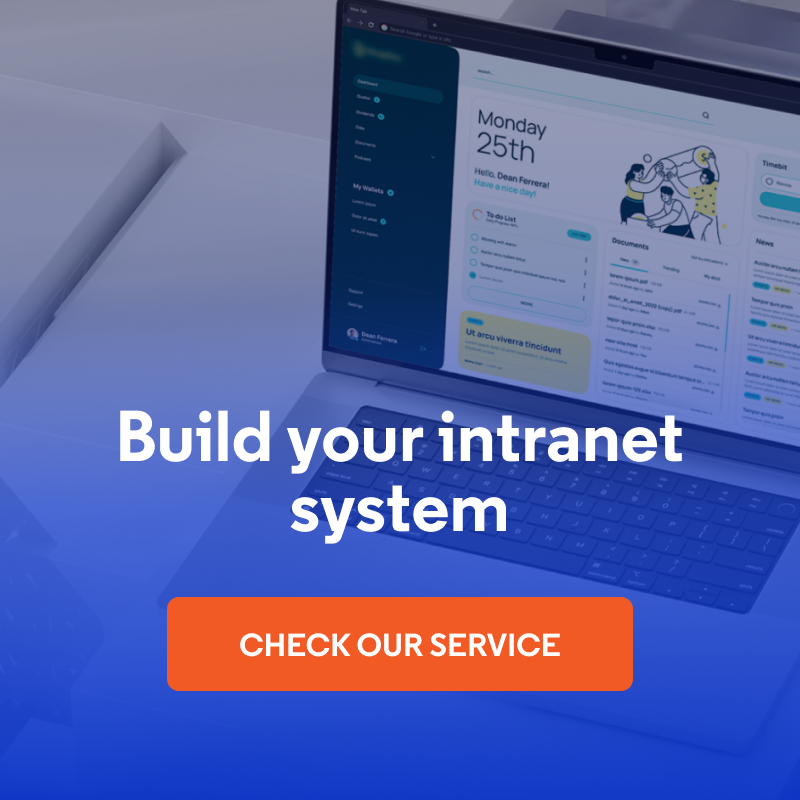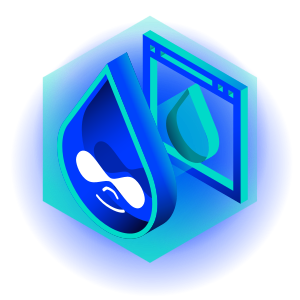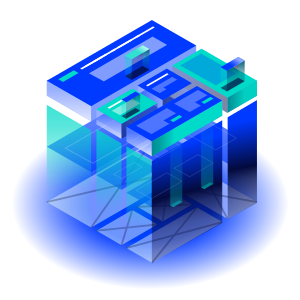
Personalized Intranet – How to Tailor It to Your Company's Needs?
A personalized intranet transforms the digital employee experience into a tool for real engagement. However, many companies still struggle with inefficient internal systems that do not meet the specific needs of the organization and its employees. The key to success is to tailor the digital workplace to the unique processes and culture of the company, creating an employee intranet that supports productivity and builds a strong organizational community.
In this article:
- Personalized intranet and digital employee experience
- What can be personalized on a company intranet?
- How does personalization affect employee engagement?
- Benefits of a personalized intranet for organizations
- Create a personalized platform with Open Intranet
Personalized intranet and digital employee experience
The digital employee experience is the sum of all interactions with technology that an employee has in the workplace. In the era of hybrid work and growing expectations for digital tools, the quality of this experience directly translates into productivity, engagement, and talent retention within the organization.
Traditional intranets often resemble digital bulletin boards—static, uniform for all users, and detached from employees' real needs. Such a system forces employees to search through irrelevant information, use multiple unrelated tools, and perform repetitive administrative tasks. The result? Frustration, wasted time, and decreased motivation to use company systems.
A personalized company intranet revolutionizes this approach by creating a digital workplace tailored to each employee's individual needs. The system "gets to know" the user—their role, department, preferences, and way of working—to deliver the most relevant content and tools. An employee from the human resources department sees different notifications than an IT specialist, and a manager has access to analytical dashboards that are not available to other team members.
Key elements of a positive digital employee experience include:
- intuitive navigation,
- quick access to the information they need,
- seamless integration with everyday work tools,
- the ability to personalize the interface according to individual preferences,
- process automation,
- smart notifications,
- personalized shortcuts.
When the employee intranet becomes the natural center of the company's digital ecosystem, employees are more likely to use it, which translates into better internal communication, more effective knowledge sharing, and a stronger sense of belonging to the organization.
What can be personalized on a company intranet?
The possibilities for personalization are vast, ranging from simple elements such as personalized greetings to advanced analytics dashboards and intelligent content recommendation systems. It is crucial to understand that each department, team, and even every employee may have completely different information and tool needs. Below are the most important areas where personalization brings the greatest benefits to the organization and its employees.
Personalization of the home page and subpages
The company intranet can greet employees by name when they log in. Additionally, you can surprise newcomers with a personalized welcome pop-up.
The home page can be completely different for each user:
- a manager will see key team metrics and upcoming project deadlines,
- a new employee will receive a widget with an onboarding plan and a list of mandatory training courses,
- an assistant can have their supervisor's meeting calendar and a list of urgent tasks,
- and a programmer will see the code build status and open pull requests that need to be reviewed.
The system can also customize the layout of the home page according to the current work context. On Monday morning, an overview of tasks for the coming week will appear in the main spot, and on Friday afternoon, a summary of achievements and a reminder to log in your work time.
You can also make each employee see a different version of specific subpages depending on which department they represent or what position they hold – HR employees will see different notifications than customer service specialists.
Subpage personalization can go much further – on the technical knowledge base page, a frontend developer will primarily see articles about JavaScript and CSS, while a backend developer will receive content about databases and system architecture. A team page can show different information to different people – productivity data and KPIs to the team leader, and current tasks and colleague availability to team members.
Subpages can also adapt the level of detail of the information – an experienced specialist will see the full technical documentation, while a person from another department will receive a simplified summary with key points. The system can also hide sections that are irrelevant to a given role and display additional options available only to specific users.
Customized messages and company news
Company news is an essential tool for strengthening employee integration. Messages are usually displayed on the home page or in a permanent section visible on all subpages. It is worth ensuring that they are tailored to employees' needs, especially if you have branches in different locations or a complex internal structure.
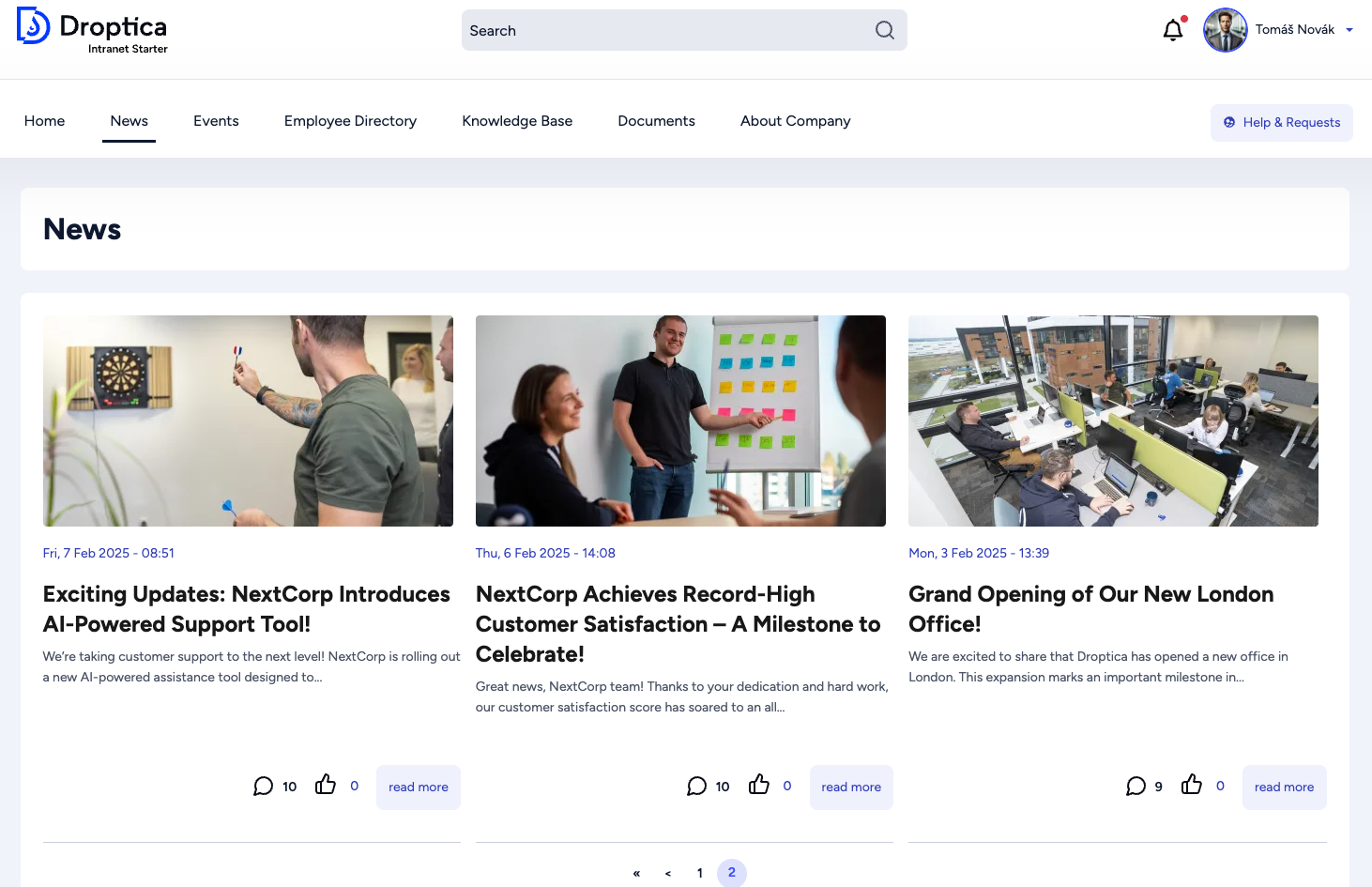
Company news visible on the home page in the Open Intranet system.
The intranet system can automatically filter messages by department, location, or job level:
- IT department employees will receive information about planned technical breaks and system updates,
- the sales team will see messages about new products and price changes,
- managers can receive management messages that are not available to other employees,
- and employees working on specific projects will be informed about the status and changes related only to their tasks.
Employees can configure how and how often they receive notifications. Some prefer instant email alerts, others prefer daily summaries, and still others want to receive only the most important messages. The modern intranet allows for detailed customization of communication preferences, respecting individual work styles and work-life balance needs.
You can also use a recommendation system that will recommend the most interesting content to employees: reports from the company's life, content from internal employee blogs or training systems, based on their profile (position, interests) and previous activity.
An intelligent news system can prioritize information according to its relevance to the user:
- new employees will first see onboarding materials and the company's success stories.
- long-term employees will receive information about career development and new projects,
- and technical team members will be kept up to date with progress in R&D and the implementation of new technologies.
Additional intranet features will speed up your team's work. Offer employees the ability to save recommended content for later review. They will be able to prepare valuable materials needed to perform various tasks and quickly return to them. In this way, they will create their own personalized knowledge bases consisting of the most important company news for them.
Personalization through integration with other tools and system extensions
Modern organizations use dozens of different tools, from CRM and ERP systems to internal communication platforms such as Slack and Teams, to specialized industry software. Personalizing your company intranet through integration means that every employee can connect their digital workplace to the systems they use most often.
A sales specialist can integrate the intranet software with the CRM system to receive notifications about new leads directly on their home page. A graphic designer will have access to the latest versions of files from the creative collaboration platform, and an analyst will see the most important metrics from data analysis tools. Each integration can be configured individually—one employee needs detailed reports, another prefers simple push notifications.
Personalization through modules and extensions
Modern intranet platforms such as Drupal offer a rich ecosystem of modules and extensions that can be installed according to the needs of specific users and teams. The HR team can use the Webform module to create job application forms. The IT department will benefit from the User Activity Log module to monitor user activity and Backup and Migrate to manage data backups.
Adaptive menus and role-based navigation
The system can dynamically adapt the menu structure and available navigation options depending on the user's role in the organization. Employees only see the sections and features that are relevant to their daily work, which greatly simplifies the use of the intranet software and reduces cognitive load. In addition, frequently used features can be automatically promoted in the menu, creating a more intuitive user experience.
Personalization of knowledge bases and documents
An intelligent knowledge management system can categorize and tag documents according to their relevance to specific roles, projects, or departments. Employees automatically see the materials that are most useful for their daily work first. The system can also track the history of viewed documents and suggest related materials, creating personalized learning paths.
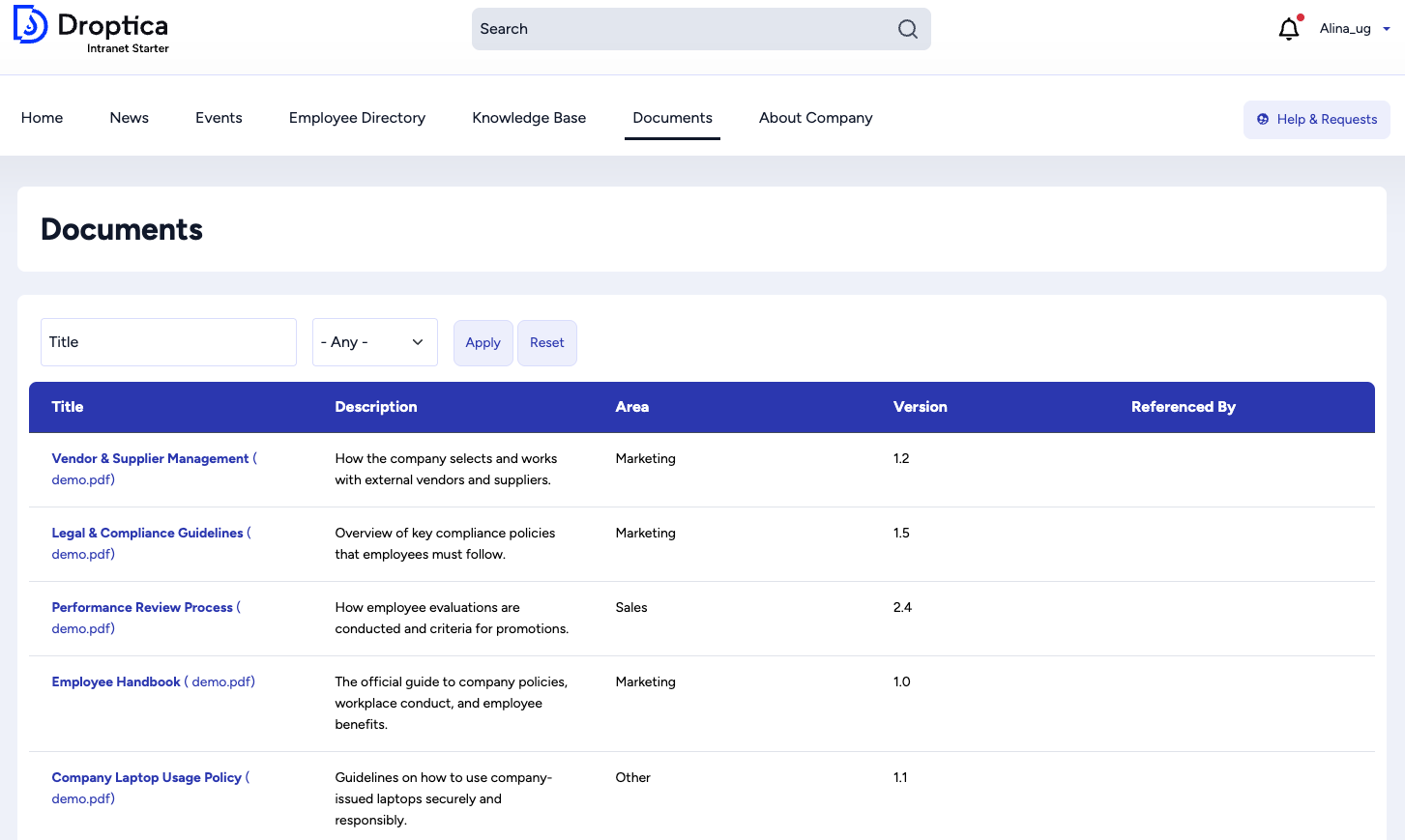
Document management section in the Open Intranet tool with filtering options.
Customized forms and workflow processes
Different roles in an organization require different approval processes and forms. A personalized intranet software can automatically adapt the workflow—a vacation request from a regular employee will go straight to their immediate supervisor, while a manager's request may require additional approval at a higher level. Forms can also be dynamically customized to show only the fields that are relevant to a given role or department.
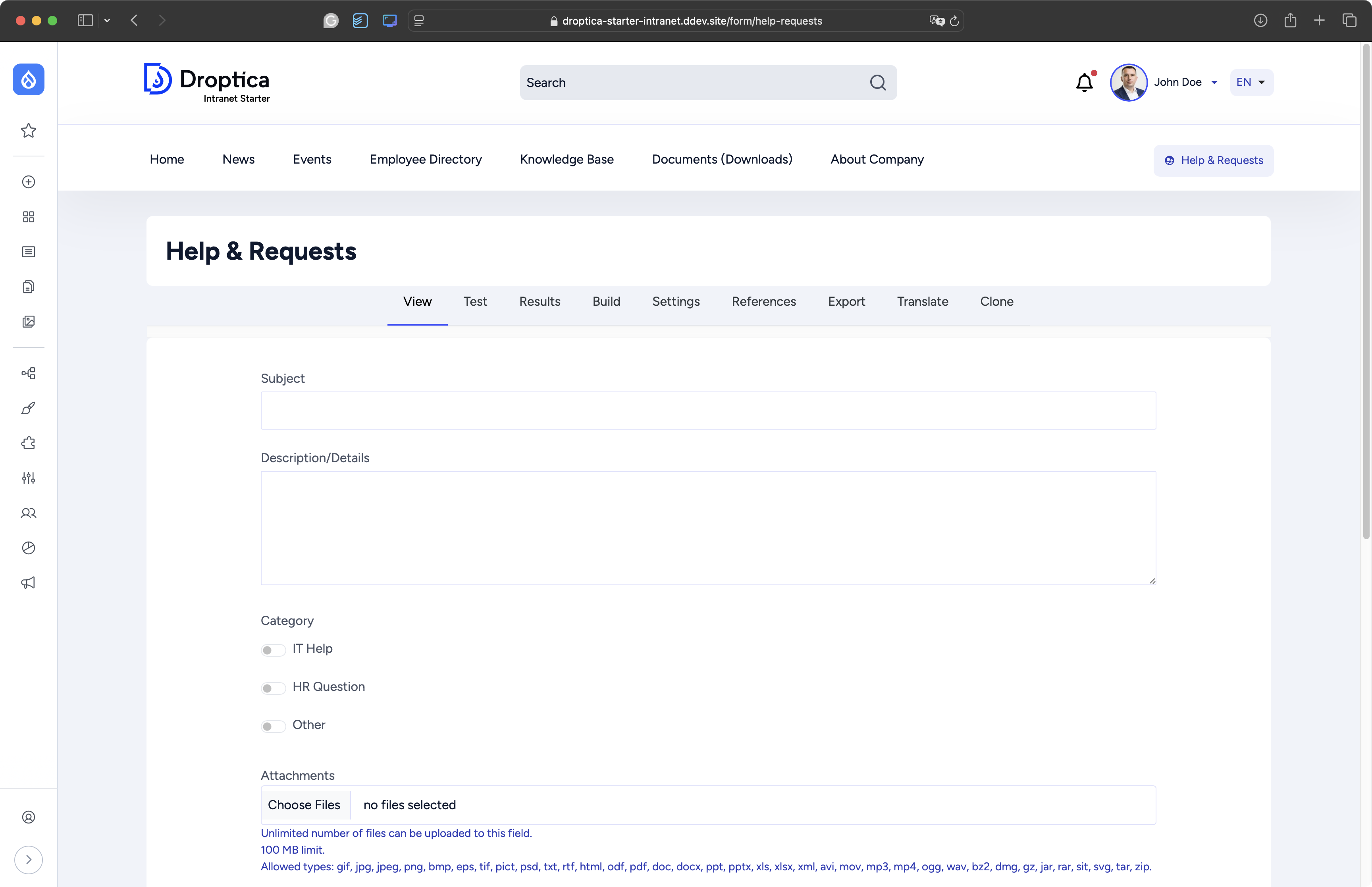
Personalized team and project spaces
Each team or project can have its own dedicated space on the company intranet, tailored to the specifics of the work. The development team will have integration with version control and bug tracking systems, the marketing team will receive tools for campaign management and content calendar, and the sales department will have access to CRM and sales materials. These spaces can be further personalized by the team members themselves, allowing them to organize their work according to their preferences.
How does personalization affect employee engagement?
Intranet personalization has a direct and measurable impact on employee engagement in an organization. When the system is tailored to the individual needs of the user, they feel seen and appreciated – their specific requirements and preferences have been taken into account in the design of the digital work environment. This feeling that the tool was created "for them" generates positive emotions and motivates them to use the company's systems more actively.
Reducing digital frustration
One of the main factors reducing employee engagement is frustration with using ineffective digital tools. When an employee has to wade through irrelevant information every day, search for functions hidden in complicated menus, or repeatedly fill in the same data in different forms, their motivation to work steadily declines. A personalized intranet eliminates these pain points by presenting each user with only what is relevant and useful to them.
Building a sense of belonging
Intranet personalization builds an emotional bond between the employee and the organization. When the system remembers user preferences, congratulates them on their achievements, and tailors communication to their work style, employees feel like part of a community rather than an anonymous "human resource". Personalized greetings, role- and department-specific news, and individual career paths reinforce the feeling that the company is investing in the individual.
This is especially important in remote and hybrid work, where natural social bonds are weakened.
Motivation for active participation
Personalization encourages employees to participate more actively in company life. When the intranet solution recommends content tailored to their interests, employees are more likely to read it than generic mass communications. They are also more likely to engage in discussions, share knowledge, and participate in company initiatives when they feel that their voice is heard and appreciated.
Personalized career paths and training recommendations show employees that the company is thinking about their long-term development. This, in turn, strengthens loyalty and motivates them to invest their own time and energy in developing skills that are useful to the organization.
Benefits of a personalized intranet for organizations
Investing in intranet personalization brings measurable business benefits to organizations that go far beyond improving employee comfort. It is a strategic approach to managing the digital workplace that translates into tangible results in the areas of efficiency, talent retention, and market competitiveness.
Increased employee engagement and satisfaction
A personalized intranet directly influences the level of employee engagement in an organization. Employees who use tools tailored to their needs show higher motivation to work and greater loyalty to the company. When the intranet solution "understands" the specifics of their role and provides relevant information, employees feel appreciated and see that the company is investing in their comfort at work. This translates into lower staff turnover and higher satisfaction rates in employee experience surveys.
Security and greater efficiency
The use of ready-made, universal solutions carries a certain risk of data leakage or cyberattack. Personalized intranet software is created taking into account the organization's individual requirements and security standards. Specialists in such solutions know how to secure company documents and information against unauthorized access.
It is worth remembering that equipping employees with the right tools by integrating them with the intranet software has a positive impact not only on their productivity but also on security. If the necessary applications are "at hand," employees will not use untrusted websites or share content outside the company in unproven applications. Centralizing tools in a secure intranet environment minimizes the risk of accidental security policy violations.
Flexibility and integration with the tool ecosystem
A personalized intranet acts as a command center for an organization's digital ecosystem. Instead of forcing employees to use dozens of scattered applications, the system integrates all the necessary tools into a single, consistent interface. This consolidation eliminates the need to constantly switch between systems and remember different logins and passwords.
The flexibility of such a solution allows for quick adaptation to changing business needs. When an organization implements a new tool or changes a process, the personalized intranet can be easily updated to reflect these changes. Employees don't have to learn a new way of working—new functionality appears in an environment they are already familiar with.
Scalability and freedom to develop the intranet software in the future
Business is constantly evolving, and so are the technological needs of organizations. A personalized intranet built on a scalable architecture can grow with your company. Adding new functionality, integrating additional systems, or supporting more users does not require a complete redesign of the system.
Drupal's modular structure allows you to gradually expand the capabilities of your company intranet without disrupting daily operations. Your organization can experiment with new intranet features, implementing them selectively for specific teams and then scaling the most successful solutions across the entire company.
More effective process standardization
Personalization can lead to better standardization of business processes. The system can present the same standards and procedures in a way that is tailored to the role and experience of each employee. A new hire will receive detailed step-by-step instructions, while an experienced specialist will only see key checklists.
Reduced training and onboarding costs
A personalized company intranet significantly reduces the time needed to onboard new employees. The system can automatically create personalized onboarding plans, present relevant training materials, and connect new employees with mentors and team members. Instead of a generic introduction, each new employee receives a path tailored to their role, experience, and needs.
The system also reduces the need for formal training, as users can discover new features and processes on their own through an intuitive interface and contextual help. This translates into concrete savings in HR and IT budgets.
Create a personalized platform with Open Intranet
Open Intranet is an open source intranet platform based on Drupal that offers the perfect foundation for building a personalized solution for your organization. Unlike closed, commercial systems, Open Intranet gives you full control over the functionality and the ability to customize every element to your specific business needs.
Ready-made modules as a starting point
Open Intranet already includes a basic set of features needed in any corporate intranet - a document management system, event calendar, news feed, employee directory, and knowledge base. Each module can be modified, extended, or completely customized to the unique needs of your organization.
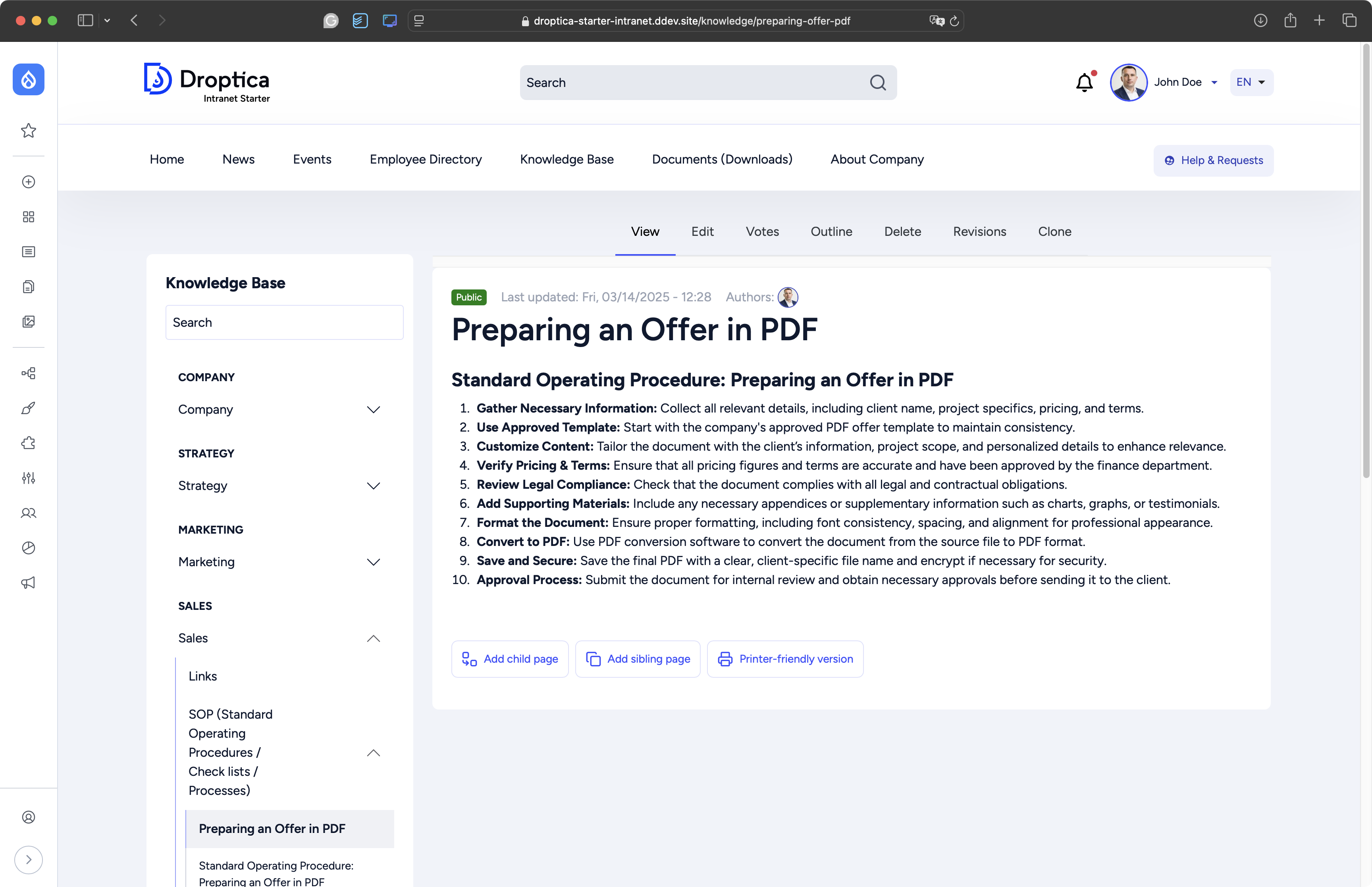
The platform also offers integration with popular business tools, from email systems and video conferencing applications to project management platforms. This flexibility means that Open Intranet can become the central hub of your entire digital ecosystem.
Personalization without technical limitations
Thanks to its open source code, the personalization possibilities of Open Intranet are virtually unlimited. The development team can create custom modules tailored to specific workflows within the organization, implement advanced role and permission systems, or build dedicated dashboards for different positions and departments.
Scalability
Open Intranet is designed for organizations of all sizes. It can support both 50-person teams and international corporations with thousands of users. The modular architecture allows for gradual expansion of functionality as the company grows—you can start with basic features and systematically add advanced functionality.
The system supports multi-site deployments, which is crucial for organizations with multiple branches. Each location can have its own version of the intranet, tailored to local needs, while maintaining consistency at the corporate level.
Total cost of ownership
The open source nature means no license fees, which significantly reduces the long-term maintenance costs of the intranet. The savings can be spent on developing dedicated functionalities or integrations with specialized business tools.
In addition, open source code means independence from a specific vendor – the organization is not tied to the roadmap of an external company and can independently decide on the direction of its intranet's evolution. It can also use the support of development agencies such as Droptica, which assists in the development and implementation of an intranet.
***
Updated article dated 26/03/2021


